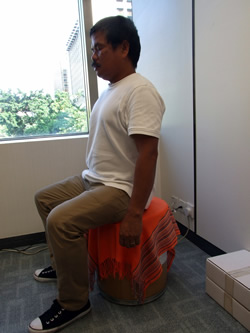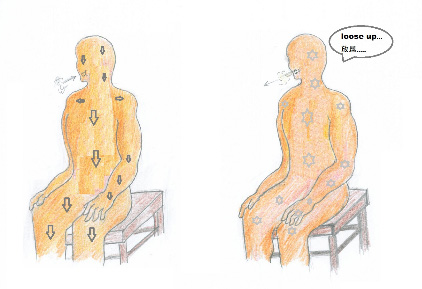|
For most hypertension cases, the underlying causes are not clear. However, specialists have confirmed that long term stress or emotional distress play a role for its development and progression. Extreme mental stress keeps the brain in a hyperactive state that sends out neurological and biochemical messages to the body regularly, leading to blood vessel contraction, faster heart beats, and less blood flowing to the peripheral body, finally a persistent elevated blood pressure is formed. Stress is a normal part of modern life, poor stress management can lead to various body signs, like headaches, stomach pain, sleeping problems, and depression. It is essential to realize the mind-body symptoms, and learn some skills to tackle the stresses of everyday life.
 |
Hypertension individuals are suitable to do relaxing and gentle exercise. |
Qi-gong is recognized as part of China's cultural heritage and one of its national treasures. Millions of Chinese citizens practice qi-gong daily, which does not aim to burn off energy, but rather to generate, store and reinforce it. Qi-gong is a mind-body practice that involves aligning the body, breath and mind to modify or induce physiological functions of the body. In comparison with other sports activities, qigong practice more emphasizes on individual mental state and its effect on health, it requires the participants to use a conscious mind or special psychological process to influence the physiological responses of the body, such as changing blood flow, relieving muscle tension or regulating respiratory movements. Constant practice helps promote health, prevent disease and develop personal potential.
There are a wide variety of qi-gong practices. Those emphasize softness, relaxation, and gentle movements such as taichi are called soft qi-gong, and are very suitable for hypertension individuals. The exercises mainly work on mental reframing, and aim at providing the maximum relief for both mental and physical tensions. When practicing in skilled, most individuals can expect a significant reduction in the blood pressure. Those who have glaucoma, digestive problems, asthma and nervous breakdown are also benefited from this. Below is a qi-gong program for high blood pressure.
Progressive relaxation qi-gong
Preparations: lying face up or sitting position; raise the tongue against the hard palate, close the eyes slightly; breath in and breath out evenly and slowly; focus the thought at a spot just below the navel.
Relaxing steps: switch your thoughts to your body, mentally scan the body, notice areas and feel the tension in them, then loosen up the areas quickly. This can let all your muscles, organs, blood vessels and nerves be relaxed generally. Scan the body as follows:
 |
Bilateral sides of the head > sides of the neck > shoulders > upper arms > forearms > wrists > hands > fingers, then focus the thought at the middle fingers for one to two minutes;
|
 |
The face > neck > chest > abdomen > front thighs > knees > front lower legs > back of the feet > toes, then focus the thought at the big toes for one to two minutes; |
 |
Back of the head > back of the neck > upper back > waist > back of the thighs > back of the knees > back of the lower legs > heels of the feet > soles of the feet, then focus the thought at the center of the soles for one to two minutes. |
In the meantime, pay attention to the respiratory movements, focus on one area when inhaling, loosen up the area when exhaling and say a mantra to yourself like “loosen up”. Play for three to five cycles each time. At the end, take the body as a whole to relax completely, and say “loosen up” to yourself again.
If you think the above program is too complicated, you can begin with a simple one first:
Relax the body, and clear your thoughts; sit straight back in a chair (lying or standing position is also ok if you feel comfortable), keep the knees in right angle and hands down naturally; make the breath even and slow; close the eyes slightly; focus the thought at a spot just below your navel; say a mantra “lower pressure” to yourself repeatedly.
Relaxation is a skill that needs to commit and practice. Qi-gong practice can be part of your relaxation routine, and it should last about 20 to 30 minutes each time. There are different types of qigong to choose from, and also with numerous adaptations and versions. The time required to attain the results varies, sometimes a person requires only a short period of time to achieve his goal, while others may take several years. Certain techniques work for some people, while others do not. For beginners, it is better to find a master for guidance.
 |
Qi-gong practice for hypertension |
|